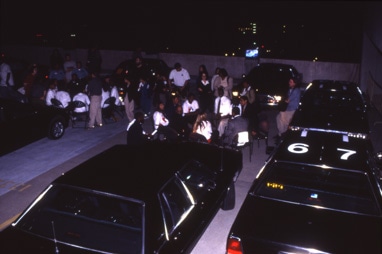The Temporality of the Snapshot
If still photography is the visual genre that best captures the trauma and loss associated with September 2001 – the sense of monumental, irrevocable change that we feel we have experienced, it is due to the photograph’s temporality. Photography interrupts, actually stops, time, freezes a moment: it is inherently elegiac. The feeling that time stopped around 9:00 a.m. on September 11 has created an immeasurable gulf separating the before from the after. Ironically what makes us feel that is precisely that the events that unfolded could not in fact be stopped, that the towers, once hit, crumbled in front of everyone’s eyes, even as rescue efforts were in full force – that the fires did not stop burning, that other buildings followed, that those who were caught in them could not get out in time. Photographic images can somehow convey a sense of this unforgiving temporality and the basic human impulse to stop it. The instantanné, the snapshot, has become the genre of the moment. 1
But to be able to stop time is also to be able to hold on to the trauma and outrage when everything conspires to forget and go back to normal. Every picture of the devastation, however grainy or imperfect, stops this gradual normalization for an instant, recalling the extraordinary that befell us, making it visible even as it is in the process of disappearing like the towers have. This becomes clear for me when I see a number of pictures of quite literal still lives – interiors covered in thick layers of dust, like Edward Keating’s beautiful image of a tea pot and cups. The picture can show the dust, but the apartment will soon be cleaned, the cups reused. And in the image it looks like our Pompeii – we can imagine being able to assess the shock of an interrupted life by looking at this one image alone.
A third element of the photograph’s temporality needs to be added to these two ways of stopping time. To photograph, we might say, is to look in a different way – to look without understanding. Understanding is deferred until we see the developed image. This deferral is as inherent to photography and as it is to trauma, enabling photography to help us understand the traumatic events of September 11. Thus, for example, one photographer injured during the collapse was surprised to see the images he had taken of the explosion after the first plane hit printed in the New York Daily News with his byline. He could not remember taking the picture. And another AP photographer reported on the “Charlie Rose” interview program on October 31, 2001 that the lab technician developing his picture called to ask him if he knew what was visible in one of his pictures of the exploding tower – a person holding on to a piece of the falling building. He had not seen that as he was shooting. Here is an example of what Walter Benjamin called the camera’s “optical unconscious” – the technologies of sight reveal more than we can see through the eye, but the realization of that supplemental revelation is deferred, as is the experience of trauma.
Thus time and space work the same way in the photograph, they expand, allowing distance and deferral. For Benjamin, the now of the image is composed of layers of interconnected moments and this is nowhere as apparent as in the images of what we call September 11 – a moment that has expanded backwards and forwards into durational time.
- No images bring this point home more forcefully than those of Bill Biggart, the photographer who lost his life when the second tower collapsed and who left an astounding set of posthumous images in his camera. See http://www.skfriends.com/wtc-biggart-album.htm.[↑]



